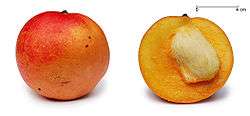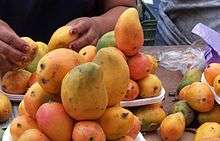Mangifera indica
| Mangifera indica | |
|---|---|
 | |
| Scientific classification | |
| Kingdom: | Plantae |
| Clade: | Angiosperms |
| Clade: | Eudicots |
| Clade: | Rosids |
| Order: | Sapindales |
| Family: | Anacardiaceae |
| Genus: | Mangifera |
| Species: | M. indica |
| Binomial name | |
| Mangifera indica | |
| Synonyms[1] | |
|
Numerous | |
Mangifera indica, commonly known as mango, is a species of flowering plant in the sumac and poison ivy family Anacardiaceae. It is native to the Indian subcontinent where it is indigenous. Hundreds of cultivated varieties have been introduced to other warm regions of the world. It is a large fruit-tree, capable of a growing to a height and crown width of about 100 feet and trunk circumference of more than twelve feet.[2]
The species domestication is attributed to India around 2000 BCE.[3] Mango was brought to East Asia around 400-500 BCE, in the 15th century to the Philippines, and in the 16th century to Africa and Brazil by Portuguese explorers.[4] The species was assessed and first named in botanical nomenclature by Linnaeus in 1753.[5] Mango is the national fruit of India, Pakistan and the Philippines.

Chemical constituents

Mangiferin (a pharmacologically active hydroxylated xanthone C-glycoside) is extracted from mango at high concentrations from the young leaves (172 g/kg), bark (107 g/kg), and from old leaves (94 g/kg).[6] Allergenic urushiols are present in the fruit peel and can trigger contact dermatitis in sensitised individuals. This reaction is more likely to occur in people who have been exposed to other plants from the Anacardiaceae family, such as poison oak and poison ivy, which are widespread in the United States.[7]
Traditional medicine
In Ayurveda, it is used in a Rasayana formula sometimes with other mild sours and shatavari (Asparagus racemosus) and guduchi (Tinospora cordifolia). In this oriental system of traditional medicine, varied properties are attributed to different parts of the mango tree, both as food and medicine.[1]
Extracts of the bark, leaves, stems, and unripe fruits have demonstrated antibiotic properties in vitro, and are used in traditional medicine.[1][2]
Wood
The tree is more known for its fruit rather than for its timber. However, mango trees can be converted to lumber once their fruit bearing lifespan has finished. The wood is susceptible to damage from fungi and insects.[8] The wood is used for musical instruments such as ukuleles,[8] plywood and low-cost furniture.[9] The wood is also known to produce phenolic substances that can cause contact dermatitis.[10]
Mango varieties
References
- 1 2 3 Shah, K. A.; Patel, M. B.; Patel, R. J.; Parmar, P. K. (2010). "Mangifera Indica (Mango)". Pharmacognosy Reviews. 4 (7): 42–48. doi:10.4103/0973-7847.65325. PMC 3249901. PMID 22228940.
- 1 2 "USDA Plant guide, Mangifera indica L." (PDF).
- ↑ Sauer, Jonathan D. (1993). Historical geography of crop plants : a select roster. Boca Raton u.a.: CRC Press. p. 17. ISBN 0849389011.
- ↑ Gepts, P. (n.d.). "PLB143: Crop of the Day: Mango, Mangifera indica". The evolution of crop plants. Dept. of Plant Sciences, Sect. of Crop & Ecosystem Sciences, University of California, Davis. Retrieved October 8, 2009.
- ↑ "Mangifera indica". Germplasm Resources Information Network (GRIN). Agricultural Research Service (ARS), United States Department of Agriculture (USDA). Retrieved October 8, 2009.
- ↑ Barreto J.C.; Trevisan M.T.S.; Hull W.E.; Erben G.; De Brito E.S.; Pfundstein B.; Würtele G.; Spiegelhalder B.; Owen R.W. (2008). "Characterization and quantitation of polyphenolic compounds in bark, kernel, leaves, and peel of mango (Mangifera indica L.)". Journal of Agricultural and Food Chemistry. 56 (14): 5599–5610. doi:10.1021/jf800738r. PMID 18558692.
- ↑ Urushiol CASRN: 53237-59-5 TOXNET (Toxicology Data Network) NLM (NIH). Retrieved 22 January 2014.
- 1 2 "Mango". The Wood Database. Retrieved 30 August 2014.
- ↑ "Economic importance of Mangifera indica". Green Clean Guide. Retrieved 30 August 2014.
- ↑ Tu, series editor, Anthony T. (1983). Handbook of natural toxins. New York: Dekker. p. 425. ISBN 0824718933.
Further reading
- Litz, Richard E. (ed. 2009). The Mango: Botany, Production and Uses (2nd edition). CABI. ISBN 978-1-84593-489-7
External links
| Wikimedia Commons has media related to Mangifera indica. |
| Wikispecies has information related to Mangifera indica |
| Wikibooks Cookbook has a recipe/module on |
- Crop of the Day: Mango, Mangifera indica has a list of helpful resources about this species.